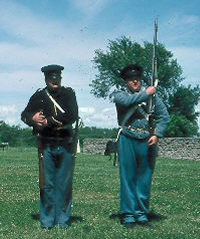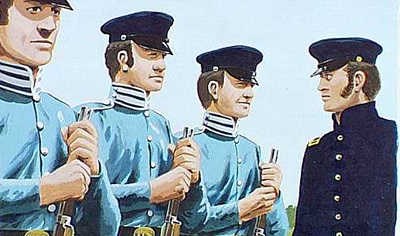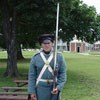
The dragoons were provided with carbines (later musketoons), pistols, and sabers. The saber was their weapon of choice from horseback. It was much easier to use than the carbine and did not have to be reloaded each time. Dragoons could also hold the saber with one hand while holding their horses' reins with the other. The disadvantage of the saber was that it could only be used at close range. Therefore, the preferred method of fighting for the dragoons was to ride into battle and then to dismount and use their side-arms, carbines or musketoons. The dragoons stationed at Fort Scott carried their weapons with them during their journeys along the overland trails. From 1843-45, First Dragoons Company A from Fort Scott joined other dragoon companies from Fort Leavenworth as they patrolled the Santa Fe and the Oregon Trails. In 1846, Company A left Fort Scott to participate in the Mexican American War. At the Battle of Buena Vista, they used their weapons to help General Zachary Taylor gain a victory over the Mexican Army, which outnumbered Taylor's men two to one. First Dragoons, Company C, which had served at Fort Scott from 1842-43, also saw action during the war, in New Mexico and California. Soon after their arrival in California, the dragoons became involved in a vicious saber duel with Mexican lancers at the Battle of San Pasqual, near San Diego. Many dragoons, including Captain Benjamin Moore, the fort's first commander, lost their lives in this battle. 
The infantry at Fort Scott did not have much of a chance to use their weapons during the first three years of the fort's existence. They spent much of their time building the fort. One major complaint from the infantry was that they spent more time using their pickaxes and shovels than they did their muskets. In 1845, 4Fourth Infantry, Companies C and D left Fort Scott and joined General Zachary Taylor's Army of Occupation. From May of 1846 to February of 1847, their muskets blazed several times as Taylor's army won a string of victories in northern Mexico. Companies C and D continued to use their weapons in the summer and fall of 1847 as they aided General Winfield Scott in his conquest of Mexico City. The Mexican American War, which ended in 1848, added a vast quantity of land to the United States. Most of the entire American Southwest was acquired as a result of the war. The soldiers of Fort Scott, both dragoon and infantry, aided in this conquest. Their weapons, muskets, carbines, and sabers, became the weapons of expansion as they helped fulfill America's Manifest Destiny of being a nation that would stretch from coast to coast. Information on this page was written by park staff. |
Last updated: October 17, 2017

